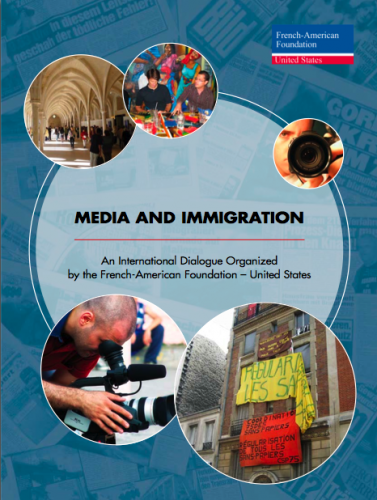
Media and Immigration: An International Dialogue Organized by the French-American Foundation
[Source: French-American Foundation, September 21, 2011]
 In November 2009 and in May 2010, the French-American Foundation convened two international symposia as part of its Media Coverage of Immigration (MCI) program, bringing together American and European media professionals and immigration experts to examine how the media cover immigration in North America and Europe. The symposia provided participating journalists with a forum to examine best practices with respect to immigration reporting as well as to identify weaknesses that often characterize coverage — all part of an effort to promote better reporting on immigration and integration issues on both sides of the Atlantic.
In November 2009 and in May 2010, the French-American Foundation convened two international symposia as part of its Media Coverage of Immigration (MCI) program, bringing together American and European media professionals and immigration experts to examine how the media cover immigration in North America and Europe. The symposia provided participating journalists with a forum to examine best practices with respect to immigration reporting as well as to identify weaknesses that often characterize coverage — all part of an effort to promote better reporting on immigration and integration issues on both sides of the Atlantic.
Immigration evokes complex questions that encompass issues of national identity, human rights and demographic shifts, all against a backdrop of vast economic change. With the North American and European press facing shrinking resources and significant changes in the media landscape, it can be difficult to provide coverage that is nuanced, accurate and compelling. This is not without consequence: the media play a major role in informing the public and in shaping the public policy debate on immigration.
The two conference locations — Paris, France for the first conference, Miami, Florida for the second — were chosen to give participating journalists firsthand exposure to the immigrant experience in Europe and North America. The media represented at the symposia included national outlets, such as The New York Times and Le Figaro, as well as local and specialized publications and networks, such as ethnic media and online entities. Participants represented eighteen countries, primarily from Europe and North America.
Each of the two conferences included in-depth seminar-style meetings, moderated by prominent journalists, academics and experts, as well as a half-day “reporting opportunity.” During each reporting opportunity, participants met with local immigrant communities and NGOs, giving participants firsthand awareness of the issues at stake in local immigrant communities in Paris and Miami. The MCI program revealed itself to be timely — each conference took place amid an active debate on immigration: the conference in Paris occurred while a debate on national identity in France dominated the airwaves, while the Miami conference followed on the heels of Arizona’s passage of a controversial immigration law.
During the symposia, journalists identified some of the common flaws in immigration coverage, which is often too episodic in nature and presents immigrants in stark terms as either “good” or “bad.” The characterization of immigrants by the press on both sides of the Atlantic displays similar tendencies, often emphasizing the “otherness” of immigrants. Participants also described similar challenges in their reporting — that of including all voices in their stories, of gaining access to sources and developing relationships with immigrant communities, whose members may be reluctant to speak to the press. They agreed that a better understanding of the dynamics of economic forces and religion can tremendously improve the quality of their work. They also found that there was greater opportunity for collaboration between mainstream and ethnic media. Finally, they examined the wider implications of their work as part of the media’s contract with society, and concluded that a prerequisite for better immigration coverage — as well as journalism as a whole — was greater diversity in newsrooms in order to reflect the expanded range of modern societies’ opinions and views.
This report presents the highlights of the debates that took place during the two conferences in Paris and Miami, and reflects on the conclusions drawn by participants. Please note that the views expressed in this report do not represent the views of the French-American Foundation nor its directors, officers, employees or representatives.
| Attachment | Size |
|---|---|
| FAFmedia_web.pdf | 1.15 MB |


